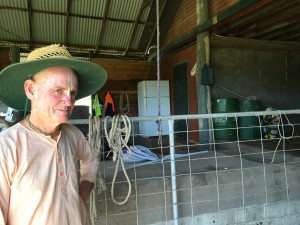I thought I had it all figured out.
My wife and I were living in South Auckland, but I was working in the CBD, twenty kilometres away from home. I was horrified at the prospect of buying an expensive car, paying for insurance, registration, and maintenance, then, every week, paying for fuel and parking. Parking in Auckland city costs seventy dollars per week. Fuel is another seventy dollars, more or less, depending on the car. And have you seen the traffic on the southern motorway in the morning and evening? It is a continuous traffic jam, taking as long as one and a half hours to get into town. No way!
Then there is the train. It takes you straight into the city, without needing to worry about parking. So far so good. However, you need to first get to the train station, a twenty-minute walk, then you need to wait for a perpetually late train to arrive, another ten minutes on a good day. After that, you need to endure thirty-five minutes sitting on a crowded train with a bunch of depressed looking people.
The train eventually arrives at Britomart station, then you must walk another ten minutes to the workplace. Altogether it takes an hour and fifteen minutes to get to work. Oh, and you need to pay fifty-six dollars per week for the privilege. Catching the train would certainly be better than driving a car, but still, a huge chunk of my day would be spent commuting.
So, what to do? I thought I was smart—I knew just the thing: a scooter. Not a piddly little sewing machine on wheels, but a big 300cc scooter weighing two hundred kilograms. This scooter is basically a motorcycle with an automatic transmission (CVT) and a more comfortable feet-forward riding position. It’s a bike powerful enough to travel on the motorway; a bike that is more fuel efficient than even the most efficient car (fuel costs me twelve dollars per week); a bike that gets free parking in various locations all over the city; a bike that can ride between the lanes to bypass the continuous Auckland traffic jam; a bike that can get me to work in thirty-five minutes flat, no matter how bad the traffic. It was the perfect transport solution.
Before long, I had completed a motorcycle driving test and bought myself a used Sym Citycom 300i for $3,500. It is such a nice scooter, cheap to purchase, has lots of storage space, and it’s fast, reliable, and stable at high speeds. What could possibly go wrong? And did I mention motorbikes get free parking in town? Great!
So, there I was, riding into town each day, rain or shine. When the traffic slowed I would pull right in between the lanes and bypass the queue, a practice known as “lane splitting.” Splitting is perfectly legal in New Zealand, as long as do it safely and responsibly—you don’t go too much faster than the surrounding traffic and you pull back into the lane once the traffic is going forty kilometres per hour or faster. Splitting also helps you avoid one of the most common types of motorcycle accidents, being rear-ended by a car.
I was happy and content, having conquered the Auckland traffic, until one day on my way to work, something unfortunate happened.

The lanes of traffic on the motorway were moving at different speeds and I was lane splitting between the fast and middle lane. As I was riding, a gap between a truck and car closed up quickly because of the speed differential. I saw the gap close up just five metres in front of me. I grabbed for the brake, but it was too late. I came up between an impossibly tight gap. While braking I tried to swerve left slightly to avoid smashing into the car, but I overcorrected and got my handlebars entangled in the side of the truck. By that time my speed had slowed sufficiently that the truck was now travelling faster than I was, and he drove off, raking the side of my bike and throwing me off balance. Before I knew what was going on, I fell left, into the middle lane, right into the path of another truck. My shoulder slammed into the asphalt, my bike entangling itself with my leg as it skidded to a halt. The driver slammed on his brakes and stopped with a few metres between his truck and me.
A few seconds later, shocked and dazed, while I was trying to take in what had happened, the driver of the truck came running to my aid. I opened my helmet visor, disentangled my foot from my bike, and stood up, with his help. Miraculously, I seemed to be unharmed—or so I thought.
Meanwhile, the driver of the car I had narrowly missed crashing into got out and inspected his vehicle, seemingly unconcerned with my well-being. He was driving a flawlessly gleaming Audi sports car. As I fell to the side my tires must have clipped the Audi, making a black scuff mark on the side door. The owner, an older man, kept angrily pointing at the scuff mark. I was thinking: “I nearly died here, and you are worried about some minor damage to your car? It’s crazy how some people are so entangled in a materialistic illusion. An illusion that convinces them they are non-different from their car; the car is them, the car is supreme, the car is holy. But my head was in too much of a jumble to express my thoughts. I just shrugged my shoulders and ignored the man.
Meanwhile, the friendly truck driver had lifted my bike up and was offering it to me. I looked it over and saw no obvious damage. I hit the starter button and the engine came to life. “Hmm,” I thought, “that could have been bad, but perhaps I can just continue on to work. No need to call the police. The scuff mark hardly qualifies as damage. Great!”
So I thanked the truck driver, continuing to ignore the irrationally angry man, and drove off. However, within a minute, my left foot started to hurt. I ignored it for a while, but it was getting worse and worse by the second. In increasing distress, I took the next exit, turned around and headed back home.
As I pulled into my street, I was chanting to myself, “Hare Krishna, just keep it together; Hare Krishna, almost there, Hare Krishna, just a few more metres.” In acute pain, I parked the scooter, pulled off my helmet, and collapsed onto the floor, sobbing, as my concerned wife came running, holding my one-year-old son.
Some minutes later, I collected myself enough to explain what had happened, and my wife took me to the hospital in her car.

Many X-rays later, the diagnosis was a severely bruised foot, but with no obvious bone damage. A nurse encased my foot in a cast, and I was discharged later that day.
A week later, I went into the clinic to get some more X-rays. The doctor, examining my foot and seeing severe bruises, told me that I probably had Lisfranc tendon injury and that I would need an operation to reattach a severed tendon. I might never gain full use of my foot again. He ordered a CT-scan to confirm exactly how bad the tendon damage might be.
I was shocked. “Oh no! What will I do? I’ll never be able to walk properly. Let alone run. But I love running. How can the world be so cruel? I’m ruined!”
My wife calmed me down and gently reminded me of the basics of Krishna conscious teachings. “Remember, you are not the body,” she said. “You are not your foot. The foot may be damaged, but the eternal soul that is your consciousness is not harmed and indeed cannot be harmed.”
“That which pervades the entire body you should know to be indestructible. No one is able to destroy that imperishable soul.” (Bhagavad-gita 2.17)
“For the soul there is neither birth nor death at any time. It has not come into being, does not come into being, and will not come into being. It is unborn, eternal, ever-existing and primeval. It is not slain when the body is slain.” (B.G 2.20)
“It is said that the soul is invisible, inconceivable and immutable. Knowing this, you should not grieve for the body.” [B.G. 2.25]
Hearing this, I said to my wife, “Oh, right, of course! I remember reading these Bhagavad-gita verses many times. Yes, I actually have nothing to worry about. I’m so lucky to be married to a wise lady who can remind me of such things.” I was actually just as much in illusion as the angry Audi driver. He thought he was his car, and I thought I was my foot. Both of our conceptions were silly.
So, I accompanied my wife home, at peace with my plight.
Another week passed. I had the CT-scan and was waiting in the doctor’s office for the diagnosis. I felt quite content with my situation, happy to accept whatever my condition might be.
The doctor called me in and showed me a 3D model of my foot, courtesy of the scan. The image showed a previously undiagnosed chipped ankle bone and fractured sesamoid bone, but no tendon damage. The two fractures would heal by themselves within the next six weeks. No operation was necessary.
I was wearing full motorcycle armour when I crashed: a helmet, armoured jacket, pants, gloves, and boots. The German Sas-Tec armour pads in my jacket protected my shoulder completely. It was not even sore. The boots (Sidi brand—aptly similar to the Sanskrit word siddhi, which refers to a mystic power acquired by long practice of yoga) saved my foot from more serious damage. My foot would have been ripped open, if I had not been wearing an armoured shoe. Within a month I could walk again and within two months I was fully recovered.
I’m still riding my scooter to work. It’s just too convenient to give up. I am, however, much more careful when lane splitting, always watching the lanes for possible gaps that might suddenly close up.
Today, gazing down at my foot, I still remember the crash. I am most happy to recall how the accident helped me practically realise that my body is not the be-all and end-all of my life. With such a conviction, any hardship can be endured, and any misery is diminished. Studying the Bhagavad-gita has taught me that my body is a wonderful machine, but nothing more. It is a vehicle that I can use to get my soul, my consciousness, into its rightful home beyond this material world, into Krishna consciousness.
“By thus engaging in devotional service to the Lord, great sages or devotees free themselves from the results of work in the material world. In this way they become free from the cycle of birth and death and attain the state beyond all miseries.” (B.G 2.51)
“For one thus satisfied [in Krishna consciousness], the threefold miseries of material existence [miseries caused by other living beings, natural forces, and one’s own mind] exist no longer; in such satisfied consciousness, one's intelligence is soon well established. (B.G 2.65)
I consider myself fortunate to have had an opportunity to realise the significance of these verses. If practical freedom from misery can be obtained, even in this life, with knowledge of the Krishna conscious teachings, then certainly, with a lifetime to learn and practice, such a state of being is readily available in the next life. Now and forever.
 Divorce happen because husbands and wives fight like cats and dogs. This happens because Krsna is not in the center. When Krsna is in the center and both husband and wife try to serve and please Krsna then there is no need for divorce. Divorce happens when one becomes self-centered and when one begins to think of one’s own enjoyment, ‘This partner of mine is not supplying my enjoyment! I want somebody else!’ But when husband and wife serve Krsna together and are fully absorbed in serving Krsna there will be no divorce.
Divorce happen because husbands and wives fight like cats and dogs. This happens because Krsna is not in the center. When Krsna is in the center and both husband and wife try to serve and please Krsna then there is no need for divorce. Divorce happens when one becomes self-centered and when one begins to think of one’s own enjoyment, ‘This partner of mine is not supplying my enjoyment! I want somebody else!’ But when husband and wife serve Krsna together and are fully absorbed in serving Krsna there will be no divorce.



 By Kaviraja Shanti Prakash Das
By Kaviraja Shanti Prakash Das
 By Radhanath Swami
By Radhanath Swami











































 By Suvyakta Narasimha Dasa
By Suvyakta Narasimha Dasa





